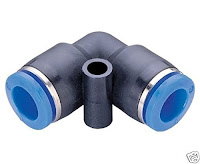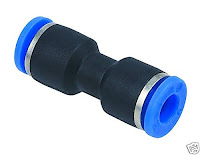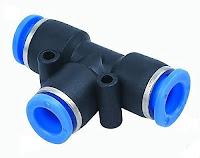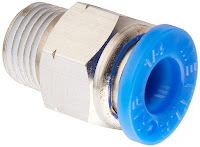First, the diagram of what's needed for my panel design.
It turns out that the wire clips under the seats are not large enough to house the wiring to the wings and the pitot-AOA lines, in the case of the left wing. So I had to drill through some of the seat ribs to route those lines.
It turns out that the wire clips under the seats are not large enough to house the wiring to the wings and the pitot-AOA lines, in the case of the left wing. So I had to drill through some of the seat ribs to route those lines.
I marked the route I wanted then used the pneumatic angle drill to start the holes with a #40 bit, then upsizing to a #30.
Then I used my electric hand drill with a right angle drill attachment and 1/4" drive unibit set to upsize each hole to their final 3/8" size so that a SB-374-4 snap bushing could fit.
The final routing for the left pitot (green) and AOA (blue) lines from the rear bulkhead to the wing root is shown below.
The air lines are from Coilhose Pneumatics NC0440, 11/64" I.D., 1/4" OD, 0.04 wall thickness. I originally purchased these for my Dynon heated pitot/AOA from Avery Tools back on 22-Aug-13 under the SafeAir1 name, however it is now available for much cheaper from MSC Direct and other sources.
Also, the push-to-connect fittings are from MettleAir. These are much less expensive than the SafeAir1 branded fittings available elsewhere. I found the MettleAir fittings on Amazon. They incorporate an NBR o-ring and stainless lock claws. Each image below links to Amazon.
My TruTrak ADI2 requires a pitot connection. Per my diagram above, it uses the right pitot so that it is independent of the EFIS' left pitot. Below is that connection. TruTrak specifies that the static connection remain unconnected in unpressurized aircraft. So the other port on the block remains unused.
The GRT AHRS gets left pitot, AOA and static connections. If you look closely, my lines come in at a slight angle to each port. I was originally concerned about that. However there are no apparent leaks even when shaking the lines.
The Winter 7 FMS 523 ASI and Winter 4 FGH 50 ALT both get static whilst the former additionally gets right pitot. These instruments were added to provide an independent and non-electric means of airspeed and altitude indications. The ASI, using the right pitot, provides a redundant indication should the left pitot get blocked. You'll notice I didn't use red tubing into the winter ALT after the elbow. For whatever reason, the barb on the pitot port was not beveled, so I just couldn't get the red tube on. Yet the white tube was more malleable and accommodating to its fitment.
Here are images showing the tee'ing of the lines as they come up from the tunnel. Left pitot and AOA tees (left), static tee (center) and right pitot tee (right).
The system appears to hold air for at least 5 minutes in all lines. I will test it more formally later.
A later post will outline the tribulations of my wiring endeavor, some of the details of which are rather prominent in the images on this post.






No comments:
Post a Comment